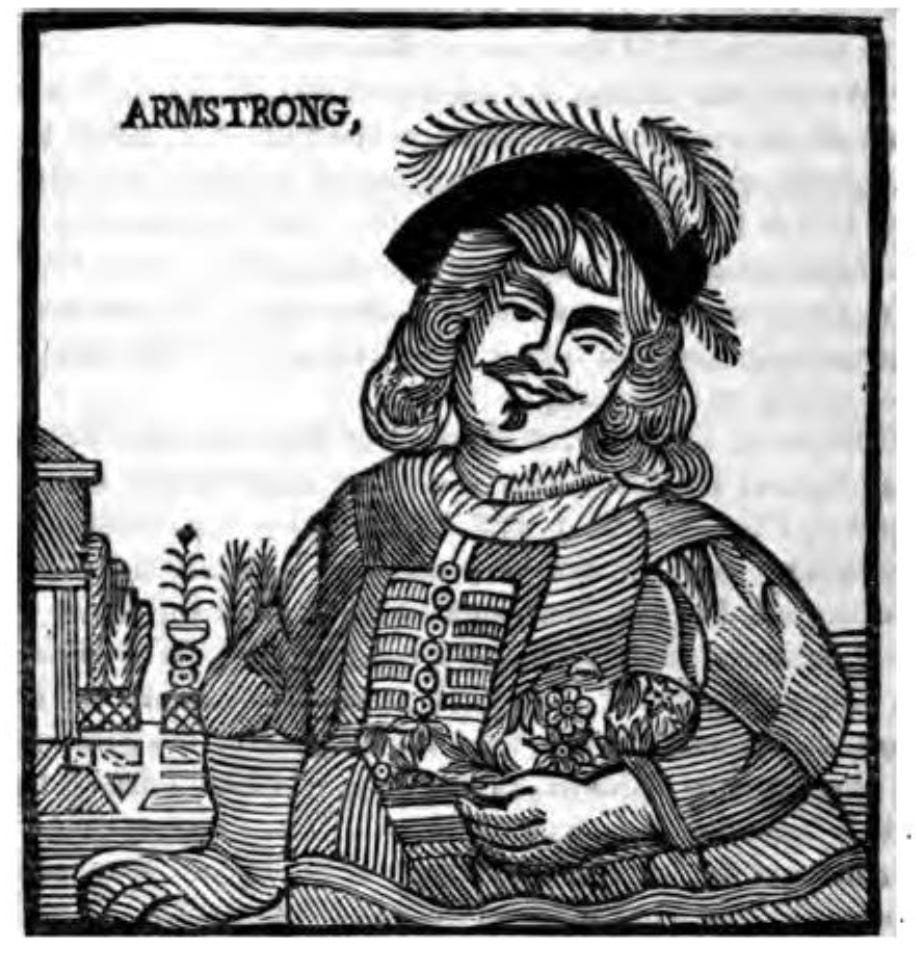ROUD 76: Johnnie Armstrong
AKA: Johnnie Armstrong's Last Farewell, Johnnie Armstrong's Last Goodbye, Johnny He's A-Ridin'
Like the previous ballad, this song is about a real person, another fearsome and rebellious Scot who came to a grisly end at the hands of the state (although this time it was the Scottish state).
Johnnie Armstrong, of the feared Armstrong clan, was one of the most notorious Border reivers in the 16th century. He ran what we would now call a protection racket, demanding payment from local farmers in exchange for not stealing their cattle, which he ran from his bijou castle in Gilnockie, in what is now the modern Scottish region of Dumfries and Galloway. He was very successful in this venture, enabling him to employ 160 fighting men.
His outlaw life came to an end in 1530, when King James V of Scotland became frustrated by Armstrong’s lawlessness (which was causing diplomatic problems with the English) and had him executed with 36 of his men, hanged in trees around the chapel. This turned out to be a terrible miscalculation by King James, whose popularity in Scotland plummeted as a result.
The ballad tells the story of Armstrong’s final fateful encounter with King James. The execution of Armstrong and his men definitely happened, but whether the king used the deception of a possible pardon to lure them to their deaths is contested and, and possibly a poetic touch from the balladeer.

Music
Here is the Youtube playlist. It’s quite a varied affair, with ranging from very traditional source-singer a capella performances, some spoken word, and a couple of interesting Americana versions (the plight of the cattle-rustling outlaw Armstrong clearly striking a chord with the cowboy spirit) as well as some beautiful modern Scottish versions.
The earliest recording of the song I can find comes from French teacher and Scottish folk song enthusiast Andy Hunter (there is very little online about Andy, but I did find this interesting interview where he talks about his folk singing life, and meeting legends of the Scottish folk song scene such as Jeannie Robertson and Hamish Henderson), from his 1984 album King Fareweel:
The tune is a Scottish air is one of a group of laments that seem to have emerged some time in the early 19th century - it’s one of the more common tunes used in modern versions, and recordings can be found of it being played as an instrumental tune. Compare this, for an example of the timeless appeal of certain tunes, to the very modern and beautiful version from Lori Watson.
Outside of streaming media, we can return to Katherine Campbell, who we met in the episode for Roud 57: “Fause Foodrage”. The same album contains an interesting variation on this ballad - clip below:
This follows the words and tune of the rare Harris version that was lost/neglected in Child’s collection. The full sleeve notes can be found on the Mainly Norfolk page. You can buy Campbell’s album here, and if you are at all interested in Scottish balladry, I would highly recommend it.
Finally, across the pond, no doubt the work of a patriotic country musician who traced their roots back to erstwhile Scottish colonisers of North America, it’s intriguing to hear this markedly Scottish tale in an Americana style. The earliest example (but I can’t guarantee the progenitor of this American version, of which you will find several examples in the playlist) is this from David Wilkie and Cowboy Celtic:
Sources
It’s fairly unusual to have actual historic accounts that not only corroborate the facts given in a ballad, but also give additional context and details to the story. In this case we have this remarkable 16th century contemporaneous account in “The history of Scotland; from 1436 to 1565” by Robert Lindsay of Pitscottie.
The first mention of this story in any sort of musical context comes once again in the 1549 Scots language anti-English propaganda piece “The Complaynt of Scotland” - which contains the first references to a number of Border ballads.
Here the author refers to a number of dances, including “Ihonne Ermistrangis Dance” - this is our ballad, although it’s unclear on the lyrical content or whether it was just a tune, and what that tune might have been is also lost, but the fact it was used as a dance tells us something. More on this can be found in the 1921 “Poetic Origins And The Ballad” by Louise Pound who gives some interesting thoughts:
The idea that Child’s collection of songs are of a specific type and mostly not suitable for the kind of rural mediaval dance party recounted in the Complaynt is certainly one that has been made elsewhere, and is worth remembering.
While Armstrong’s execution is verified, the historical accuracy of the claim in the song that King James lured Armstrong to meet him on a deceptive promise of a pardon is surely an embellishment, since, as pointed out by Maidment, this detail would be mentioned in the historical accounts.
As a side note, Maidment also published this handsome portrait of Armstrong, from an undated broadside in the ownership of one Mr Gibb.
Other depictions of Armstrong and the event can be found in broadsides in the Bodleian collection. This sheet uses a depiction of Armstrong leading his men to their unknowing demise.
Also this, from this broadside, showing Armstrong and presumably his grieving wife.
Finally this account from an 1832 edition of popular magazine Chambers’ Edinburgh Journal contains not only one of the more characterful accounts of the events of the ballad, but also repeats the idea that an unjust death causes supernatural horticultural decay. This phenomenon was noticed recently in the entry for ROUD 58: Jellon Grame.
Draft pages and audio guide
Keep reading with a 7-day free trial
Subscribe to Sing Yonder: A Practical Guide to Traditional Song to keep reading this post and get 7 days of free access to the full post archives.














